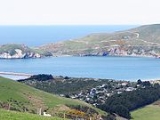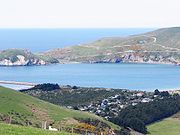
Aramoana
Encyclopedia
Aramoana, also known as "The Spit
" to locals, is a small coastal settlement, 27 kilometres north of Dunedin
city, in the South Island
of New Zealand
. The settlement's permanent population in 2001 Census
was 261. Supplementing this are seasonal visitors from the city who occupy cribs
. The name Aramoana is Maori
for "pathway to the sea".
Originally founded by The Otago Harbour Board, established in the 1880s as an ideal pilot station for navigation around the mouth of the Otago Harbour, this area grew into a small farming village. In the 1950s the town became popular as a beach resort and a rural life village due to the construction of a mole
, to inhibit the spread of tidal sands into the mouth of the Otago Harbour and was surveyed and amalgamated as a suburb of Port Chalmers borough.
It is the site of New Zealand
's deadliest criminal shooting
, which occurred on 13 and 14 November 1990.
 The settlement is located on a sand dune Spit
The settlement is located on a sand dune Spit
at the mouth of the Otago Harbour
, opposite the end of the Otago Peninsula
. The main channel of the harbour is kept clear by the Aramoana mole, an artificial breakwater which extends for 1200 metres from Aramoana. The mole was originally intended to extend another 600 meters into the ocean, however due to tidal patterns and the instability of the construction, no attempt to extend beyond the current length was thought to be possible.
To the southwestern side of the township extend expansive salty mudflat
s from the head of the Aramoana Spit around the habourside to the township of Te Ngaru. This area is a protected Wildlife Sanctuary, which hosts a range of plant and animal life, both native and exotic.
On the other side of the Spit is an expanse of beach, truncated by the Aramoana Mole. The beach and sand dunes to the east are known as Shelly Beach. The beach to the west is known as Big Beach and, extends for over two kilometers. At points along this beach, steep rockfaces come down to the waterline. These are well used for practical training by local rock-climbers. Seals can be found sun bathing on the rocks of the spit.
The Save Aramoana Campaign was formed in 1974 to oppose the smelter.
A monument to the 13 victims stands on the dunes near to the Aramoana Mole.
In 2006, New Zealand director Robert Sarkies
released a film based on the events, Out of the Blue
, starring successful NZ actor Karl Urban
.
Spit (landform)
A spit or sandspit is a deposition landform found off coasts. At one end, spits connect to land, and extend into the sea. A spit is a type of bar or beach that develops where a re-entrant occurs, such as at cove's headlands, by the process of longshore drift...
" to locals, is a small coastal settlement, 27 kilometres north of Dunedin
Dunedin
Dunedin is the second-largest city in the South Island of New Zealand, and the principal city of the Otago Region. It is considered to be one of the four main urban centres of New Zealand for historic, cultural, and geographic reasons. Dunedin was the largest city by territorial land area until...
city, in the South Island
South Island
The South Island is the larger of the two major islands of New Zealand, the other being the more populous North Island. It is bordered to the north by Cook Strait, to the west by the Tasman Sea, to the south and east by the Pacific Ocean...
of New Zealand
New Zealand
New Zealand is an island country in the south-western Pacific Ocean comprising two main landmasses and numerous smaller islands. The country is situated some east of Australia across the Tasman Sea, and roughly south of the Pacific island nations of New Caledonia, Fiji, and Tonga...
. The settlement's permanent population in 2001 Census
Census
A census is the procedure of systematically acquiring and recording information about the members of a given population. It is a regularly occurring and official count of a particular population. The term is used mostly in connection with national population and housing censuses; other common...
was 261. Supplementing this are seasonal visitors from the city who occupy cribs
Bach (New Zealand)
A bach is a small, often very modest holiday home or beach house. Alternatively called a crib, they are an iconic part of New Zealand history and culture, especially in the middle of the 20th century, where they symbolized the beach holiday lifestyle that was becoming more accessible to the...
. The name Aramoana is Maori
Maori language
Māori or te reo Māori , commonly te reo , is the language of the indigenous population of New Zealand, the Māori. It has the status of an official language in New Zealand...
for "pathway to the sea".
Originally founded by The Otago Harbour Board, established in the 1880s as an ideal pilot station for navigation around the mouth of the Otago Harbour, this area grew into a small farming village. In the 1950s the town became popular as a beach resort and a rural life village due to the construction of a mole
Mole (architecture)
A mole is a massive structure, usually of stone, used as a pier, breakwater, or a causeway between places separated by water. The word comes from Middle French mole and ultimately Latin mōlēs meaning a large mass, especially of rock and has the same root as molecule.Historically, the term "mole"...
, to inhibit the spread of tidal sands into the mouth of the Otago Harbour and was surveyed and amalgamated as a suburb of Port Chalmers borough.
It is the site of New Zealand
New Zealand
New Zealand is an island country in the south-western Pacific Ocean comprising two main landmasses and numerous smaller islands. The country is situated some east of Australia across the Tasman Sea, and roughly south of the Pacific island nations of New Caledonia, Fiji, and Tonga...
's deadliest criminal shooting
Aramoana massacre
The Aramoana massacre was a mass murder that occurred on 13 November 1990 in the small seaside township of Aramoana, New Zealand. Resident David Gray, a 33-year-old unemployed man, began indiscriminately shooting people in the township with a scoped semi-automatic rifle, after a verbal dispute with...
, which occurred on 13 and 14 November 1990.
Location and natural environment

Spit (landform)
A spit or sandspit is a deposition landform found off coasts. At one end, spits connect to land, and extend into the sea. A spit is a type of bar or beach that develops where a re-entrant occurs, such as at cove's headlands, by the process of longshore drift...
at the mouth of the Otago Harbour
Otago Harbour
Otago Harbour is the natural harbour of Dunedin, New Zealand, consisting of a long, much-indented stretch of generally navigable water separating the Otago Peninsula from the mainland. They join at its southwest end, from the harbour mouth...
, opposite the end of the Otago Peninsula
Otago Peninsula
The Otago Peninsula is a long, hilly indented finger of land that forms the easternmost part of Dunedin, New Zealand. Volcanic in origin, it forms one wall of the eroded valley that now forms Otago Harbour. The peninsula lies south-east of Otago Harbour and runs parallel to the mainland for...
. The main channel of the harbour is kept clear by the Aramoana mole, an artificial breakwater which extends for 1200 metres from Aramoana. The mole was originally intended to extend another 600 meters into the ocean, however due to tidal patterns and the instability of the construction, no attempt to extend beyond the current length was thought to be possible.
To the southwestern side of the township extend expansive salty mudflat
Mudflat
Mudflats or mud flats, also known as tidal flats, are coastal wetlands that form when mud is deposited by tides or rivers. They are found in sheltered areas such as bays, bayous, lagoons, and estuaries. Mudflats may be viewed geologically as exposed layers of bay mud, resulting from deposition of...
s from the head of the Aramoana Spit around the habourside to the township of Te Ngaru. This area is a protected Wildlife Sanctuary, which hosts a range of plant and animal life, both native and exotic.
On the other side of the Spit is an expanse of beach, truncated by the Aramoana Mole. The beach and sand dunes to the east are known as Shelly Beach. The beach to the west is known as Big Beach and, extends for over two kilometers. At points along this beach, steep rockfaces come down to the waterline. These are well used for practical training by local rock-climbers. Seals can be found sun bathing on the rocks of the spit.
Save Aramoana Campaign
In the late 1970s Aramoana was proposed as the site of a major aluminium smelter by a consortium of New Zealand-based Fletcher-Challenge, Australia's CSR Limited and Swiss firm Alusuisse. An aluminium smelter was already operating at Tiwai Point when the smelter at Aramoana was proposed.The Save Aramoana Campaign was formed in 1974 to oppose the smelter.
Aramoana massacre
Aramoana gained notoriety as the site of a mass murder that occurred on 13 November and 14 November 1990. Resident David Gray, an unemployed gun collector, went on a rampage in which 13 people were shot dead, before Gray himself was shot by police.A monument to the 13 victims stands on the dunes near to the Aramoana Mole.
In 2006, New Zealand director Robert Sarkies
Robert Sarkies
Robert Sarkies is a New Zealand film director and scriptwriter.Sarkies grew up in the South Island city of Dunedin, and his two feature films released to date have been set in Dunedin, or close by. He began making short films as a teenager with fellow filmmaker Simon Perkins...
released a film based on the events, Out of the Blue
Out of the Blue (2006 film)
Out of the Blue is a 2006 New Zealand film directed by Robert Sarkies and starring Karl Urban. The film premiered at the 2006 Toronto Film Festival in Canada and was released in New Zealand on 12 October 2006 to minor controversy...
, starring successful NZ actor Karl Urban
Karl Urban
Karl-Heinz Urban is a New Zealand actor.He is known for playing Éomer in the second and third installments of Peter Jackson's The Lord of the Rings trilogy, Dr. Leonard "Bones" McCoy in the 2009 film Star Trek and Julius Caesar on Xena: Warrior Princess...
.

